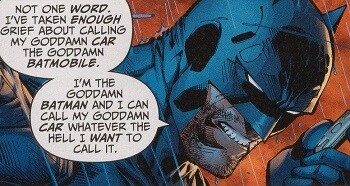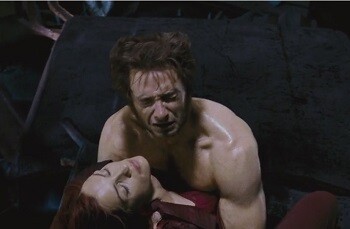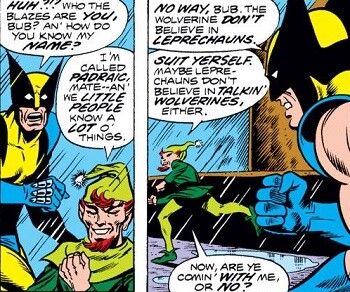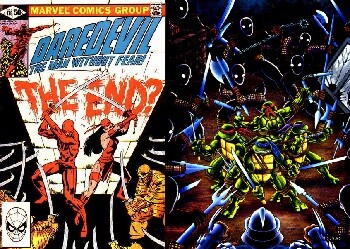No More Dark Phoenix, Please: 5 Famous Superhero Stories Hollywood Needs To Quit

It would be weird if every Avengers movie included a purple villain snapping away half of life in the universe, or if every Spider-Man one featured a different girlfriend getting dropped off a bridge by a guy in a glider -- but that's pretty much what happens in other franchises. Some superhero stories are so iconic that fans lost their shit the first time a single line of dialogue ended up in a movie or TV show ... but by now it's like, ugh, we get it already. Here are some very good comics that don't need to be on the big screen anymore, thanks:
The Dark Knight Returns Is Past Retirement Age
The Classic Comic:
Batman is old and grumpy (well, grumpier) and comes back to action to beat up punks. Also, he drives a tank now!
It Shows Up In ...
Obviously, the Zack Snyderverse borrowed a lot from The Dark Knight Returns, from the "older Batman who gets off on breaking bones" premise to the glowy-eyed armor Bruce Wayne apparently keeps in his closet in case Superman ever needs a whooping.

Warner Bros. Pictures, DC Comics
But TDKR is all over the Chris Nolan trilogy, too -- there's the Bat-tank in all three movies, the gun-toting Batman copycats in The Dark Knight, and the fact that The Dark Knight Rises features Bruce Wayne coming out of retirement after years of depression, only to fake his own death a while later. The movie even cribs some dialogue from the comic:

DC Comics

Warner Bros. Pictures
Tom Hardy's speech impediment-suffering version of Bane plays a similar role to The Dark Knight Returns' Mutant Leader: both are large fellas who totally crush Batman when he's kind of out of practice, then get crushed on the rematch in front of all their followers.

DC Comics, Warner Bros. Pictures
And you know the climatic talk show interview scene from Joker? That's also inspired in this comic, only this one is with a David Letterman lookalike instead of Robert De Niro and the kill count is somewhat higher.

DC Comics

DC Comics
Over on the TV side, The CW's Crisis on Infinite Earths event featured an older Batman who fought (and killed) Superman at some point and quotes directly from the comic. Batman: The Animated Series also had a whole The Dark Knight Returns segment, and even the kid-friendly Batman: The Brave and the Bold cartoon had a Superman vs. mecha-Batman battle ... which does deviate from the source material when it turns into a fight between Superman and his flying super-dog, though.

Warner Bros. Animation
And that's without counting the two-part animated adaptation of the entire comic, plus other shout outs and references in Batman media here and there. At some point, all Batman adaptations feel like they have to pay dues to the idea of the hero becoming an ultra-violent geriatric vigilante in the future -- even Joel Schumacher wanted to do a TDKR movie in the '90s, which probably would have necessitated sculpting old man-style hairy nipples in latex.
The irony is that, for all its iconic visuals and all the reverence it has inspired in Hollywood, The Dark Knight Returns isn't actually a very cinematic comic. Its ultra-dense 16-panel grid and million caption boxes per page make it a great example of what comics can do, but these things don't really translate well to movie form, because they're not supposed to. Add that to the fact that Frank Miller's dialogue might look good on the page but should never, ever be said out loud.

DC Comics
There are other versions of Batman's future that are much better suited to live action adaptations, like the ones in Kingdom Come or Batman Beyond, but we probably won't get to see them until the world looks like the futuristic Neo Gotham from the latter.

Warner Bros. Animation
No More "Dark Phoenix Saga," Please
The Classic Comic:
The X-Men's most famous non-bald telepath gains cosmic powers and promptly goes evil, because as the saying goes: hair corrupts, fabulous hair corrupts fabulously.
It Shows Up In ...
"The Dark Phoenix Saga" had an excellent season-long adaptation in the '90s X-Men cartoon, and ... they probably should have stopped there. The next animated series, X-Men: Evolution, teased Jean's cosmic heel turn but never delivered the goods. The original movie trilogy did, although "goods" might not be the correct term here.

20th Century Fox
Only three years after X-Men: The Last Stand botched the story, the Wolverine and the X-Men cartoon wasted no time and devoted several episodes to "Dark Phoenix" on its first (and, as it turned out, last) season. Then, the 2011 X-Men anime series broke the record and started with this stuff, right there on the first scene.
The Jean Grey character was given a break from going evil on the First Class and Days of Future Past movies, but she was back on her BS by the end of Apocalypse. And, of course, 2019's Dark Phoenix managed to top The Last Stand by taking the same basic plot and somehow making it even dumber.

20th Century Fox

20th Century Fox
It's kinda impressive that this is still seen as the definitive X-Men tale when it's responsible for not one but two sub-60% on Rotten Tomatoes movies. Maybe the reason the '90s cartoon got it right is because it was the only adaptation that took its sweet time to tell the story -- the original Phoenix saga in the comic spanned almost 40 issues, from Jean getting a power boost to her slowly losing her humanity to her final corruption. In the movies, she gets fiery eyes in the first act and is disintegrating folks 40 minutes later. Even though her comics version never murdered other X-Men, at this point Jean Grey is more famous for killing her pals (and movie franchise) than for her half century of stories.
It's a given that Marvel Studios will tackle "Dark Phoenix" when they get around to rebooting the X-Men, but here's a wild concept: don't. Just let Phoenix stay dead for once and focus on some of the 8,000 other classic X-Men storylines that have never made it outside comics, like maybe the one where Wolverine hangs out with leprechauns.

Marvel Comics
Enough With Teen Titans' "Judas Contract"
The Classic Comic:
The Teen Titans welcome a girl named Terra into the team, but she pulls a Judas and tries to kill them all. Then she dies and the day is saved. Tragically young death, FTW!
It Shows Up In ...
The Teen Titans haven't even had that many adaptations, yet almost all of them use this story, with the exception of the live action Titans show (so far, though it's been rumored for a while) and this 16-second anti-drug PSA from the '80s:
Like the comics, the 2003 Teen Titans Non-Go! cartoon introduced Terra as a hero, only to reveal that she was a mole for the villain Deathstro-- sorry, "Slade." And, in keeping with the show's "no death" rule, they changed her final fate from "she goes psycho and crushes herself under some rocks" to "she heroically sacrifices herself and gets turned into a statue." It's probably for the best that they also left out the part where she was clearly having sex with her grown-ass boss, despite being 15.

DC Comics
You'd think present day DC would stay away the hell from that part of the storyline, especially with Deathstroke as a popular anti-hero with his own comic and movie cameos, but no: in the 2017 Teen Titans: Judas Contract animated movie, once Terra's betrayal of the Titans is revealed she's immediately trying to hump his middle-aged bones (as you can see in some of the amateur music videos people on YouTube have made about them, because they'll do those for literally anyone). He pushes her away, but only because they have to wait until the Titans are dead before they can "be together." Which is pointless, because we're pretty sure there are other superheroes out there who are aware of statutory rape laws.

Warner Bros. Animation
This Terra also ends up crushed under rocks after a last minute The Grinch-like change of heart. Terra appears as a turncoat hero once again in Young Justice: Outsiders (2019), another animated series about superpowered teens, though she eventually turns the coat back in and joins the good guys for real in that one. Even the wacky Teen Titans Go! show did its own version of this sad tale:
This Terra ends up being thrown into a giant trash heap in another dimension, which is this universe's even more unpleasant equivalent to death.
Instead of honoring the original storyline, all this stuff does is dilute its impact. What made "The Judas Contract" work in the comics was how shocking it was -- no one expected this blonde girl to be a ruthless manipulator, but now even 8-years-old know that Terra is evil. If Titans truly wants to capture the spirit of the comic, they'll make it so the traitor is someone completely unexpected, like Beast Boy, or Robin, or ... hell, even the actual Judas from the Bible would be more surprising than Terra by now.
There's More To Daredevil Than Frank Miller's Stuff, You Know
The Classic Comic:
Daredevil falls in love with an assassin, but then she's dead, but then she isn't. Then he becomes a hobo for a while.
It Shows Up In ...
This is a special case because this saga was already being lambasted in pop culture before it even got a chance to be adapted -- you know how the evil ninja clan in Daredevil is called The Hand and the Teenage Mutant Ninja Turtles' baddies are called The Foot? That's not a coincidence. TMNT started as a parody of Frank Miller's gritty, ninja-heavy take on Daredevil (plus other popular '80s comics trends, like mutants or teen heroes).

Marvel Comics, Konami

Marvel Comics, IDW Publishing
Ben Affleck's Daredevil (2003) was heavily based on Miller's stuff: the whole thing about DD bumping into his old college flame Elektra, having to fight her, and then watching her get killed by the Kingpin's personal hitman, Bullseye, was lifted straight from the comic. They even kept the exact way she died, which was "stabbed with her own sai after having her throat sliced with a playing card" (the third leading cause of death in NYC).

Marvel Comics, 20th Century Fox
This Elektra, like her counterpart in Miller's stories, comes back to life in her own (regrettable) movie featuring The Hand. Netflix's Daredevil show also leaned on Miller's work: season one had Kingpin as the main bad guy and season two sprung Elektra on us again, complete with sai-induced death. And, again, bleeding out from a stomach wound didn't stop her from coming back in a spin-off, The Defenders. Meanwhile, season three of Daredevil took clear inspiration in the Miller storyline that would have served as the basis for a second Dareffleck flick, Born Again, in which Matt Murdock's life goes to hell after the Kingpin learns his identity and he ends up living in a convent for a while.

Marvel Comics, Marvel Television
This season also introduced Bullseye, though he goes by the less intimidating name of "Dex Poindexter." So that's two movies and four seasons of television at least partially based on the same stretch of issues from the mid-'80s. The sad thing is that there are acclaimed Daredevil eras that have barely been touched by the adaptations, like the ones written by Brian Michael Bendis or Ann Nocenti. Nocenti's issues, despite also being from the '80s, feel more relevant today than almost anything on Miller's.

Marvel Comics

Marvel Comics

Marvel Comics
So far, the only live-action nods to Nocenti's work are through her character Typhoid Mary ... in the Elektra movie and Netflix's Iron Fist, some of Marvel's biggest turds. Further proof that sometimes, the best adaptation is no adaptation.
It's Time To Kill The Killing Joke
The Classic Comic:
The comic that established that all it takes to turn a sane person into the Joker is one bad day. (Also some bleach and hair dye and expertise in chemical engineering.)
It Shows Up In ...
In some form or another, The Killing Joke has informed every cinematic Joker appearance so far. Tim Burton called it the first (only?) comic he ever loved, though he makes it sound like it was more due to the easy-to-follow panel placement than the actual story. Still, you can see the influence in the 1989 Batman movie -- specifically, in the idea that the Joker's little chemical bath triggered his psychotic break.

DC Comics
Chris Nolan went all in with The Dark Knight and based a big part of the movie on The Killing Joke's notion that we're all "one bad day" away from writing death threats to Batman with our own poop on the walls of a padded cell. Both stories are about the Joker trying to corrupt one of Batman's buddies, and both also play with the idea that not even he is sure what his secret origin actually is.

Warner Bros. Pictures
Joaquin Phoenix's Joker also owes a lot to The Killing Joke: that's where the entire idea of the character as a hapless comedian broken down by his depressing life circumstances originally comes from. On a deeper level, all three movies follow the theme of Batman and the Joker as two sides of the same coin -- one always enables the circumstances that create the other. And on a wholly superficial level there's Jared Leto's Joker in Suicide Squad, whose director once tweeted a photo that kinda looks like The Killing Joke's cover, just to say "That's right, I've read this too!"
But then, Zack Snyder's Justice League's epilogue (mild spoilers ahead for those who started watching this thing weeks ago and are still halfway through it) brings this Joker in line with the other movies' Batman/Joker symbiosis, with all its talk about "needing each other" and giving each other friendly reach-arounds. But, see, in the comics, this is only one of many takes on Batman and the Joker -- there are literally hundreds of stories where they can be enemies without any talk of chronic co-dependence. Joker doesn't always have to be the definitive villain in the franchise: he also works perfectly well as a guy doing his own thing who occasionally bumps into Batman and is like "not this a-hole again" instead of "YOU COMPLETE ME."
Hopefully the next Bat-franchise lets some other villain take the center stage. We're rooting for you, Kite Man.
Follow Maxwell Yezpitelok's heroic effort to read and comment every '90s Superman comic at Superman86to99.tumblr.com.
Top Image: Warner Bros. Pictures